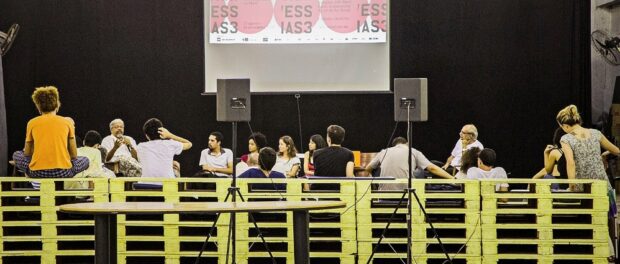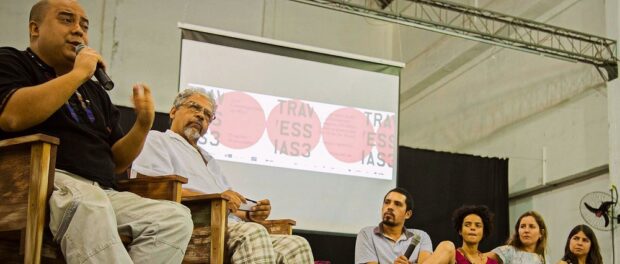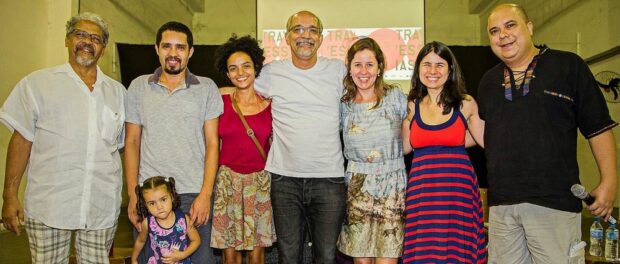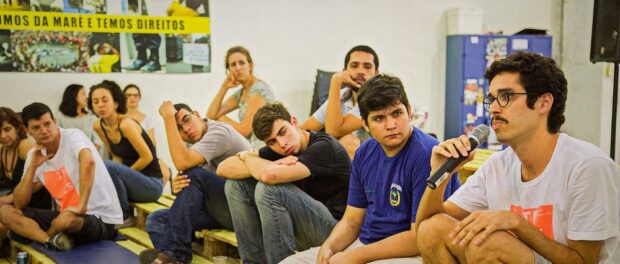
A discussion on the aesthetics of the urban periphery and their role in contemporary culture took place at Maré Art Center in Complexo da Maré, North Zone, on Saturday November 8. Photography collective Imagens do Povo, Fluminense Federal University (UFF) anthropology professor Julio Tavares and Heraldo HB from the Mate com Angu film club in the Baixada Fluminense participated in the debate, which was mediated and hosted by the Observatório de Favelas’ (Favelas Observatory) Jorge Barbosa as part of the Travessias 3 Art Festival. The festival has been extended to November 22.

Revolutionizing the way we look at favelas
Founded by the Observatório de Favelas, Imagens do Povo is a center of documentation, research, training and market insertion of photographers from low income regions. Their work exhibits, celebrates and looks critically at everyday life in Rio’s favelas and urban periphery.
“People here keep revolutionizing the ways of thinking about the city and showing our own photographers’ visions,” said Rovena Rosa, current Imagens do Povo coordinator and former student.
Created in 2004, the Imagens do Povo program unites photography techniques with critical attitudes towards social issues in work which often looks to defend human rights and portray various local cultures.
“Each person has their own aesthetics and themes,” explained Rosa. Imagens do Povo trains photographers and currently has around 70 members in the photography collective. They also promote their art by participating in exhibitions in Rio de Janeiro and internationally, in London and New Orleans.
“We show people’s day-to-day lives and humanize this space,” said Erika Tambke of Imagens do Povo. “This already changes a lot of the city’s aesthetics, and the city’s photography that is too focused on the South Zone and the Center…The very act of taking pictures creates subjectivities and territories.”
Thaís Rocha, also a member, pointed out that their work also looks critically at government policies in the favelas: “We address social issues, like the Pacifying Police Units,” she said. “There’s a strong social questioning.”
Some of their works can be seen at Travessias 3’s gallery, or at the weekly Galeria 535 exhibition at the Observatório de Favelas in Maré. The project launched its first book in 2012.

Center vampirism or cannibalism of peripheries
Heraldo HB is a cultural producer based in the Baixada Fluminense. He has worked with open radio, university prep courses, and Internet and communication projects. He has worked with film and cinema through the Mate Com Angu Cineclub project for the last eight years.
Heraldo explained how the Brazilian elite are ashamed of the poor and attempt to “whiten” society and make the black, poorer population invisible. On the other hand, he pointed out, some leftist politicians and thinkers regularly idealize favela residents and Brazilians of African descent and impose their own limiting definitions. Heraldo celebrated the ways in which people are increasingly directly engaging and expressing themselves free from outside definition. “We are now showing our face, with as few intermediaries as possible,” he concluded.
Julio Tavares is a researcher and professor from Fluminense Federal University (UFF). His work is focused on the representation of black people in media, the African diaspora in South America, racism and discrimination, the body and ethnicity.
“The cannibalistic attitude is only legitimized for the center, not the peripheries, which have to remain ‘authentic,’ frozen in an intensely stylized form of popular culture,” he said.
Continuing the discussion of power structures, Tavares gave examples of how the center has historically exploited the peripheries via domination and vampirism, such as the colonial relationships between European countries and regions in Asia, Africa and the Americas. In Rio de Janeiro, for example, the music genre bossa nova was born in the wealthy South Zone but borrowed heavily from renegade samba and American jazz.
Tavares argued the necessity to fully decolonize the idea of folklore, usually considered to be of lower quality in respect to higher, erudite culture. This idea has disqualified and segregated some cultures, isolating them from communicating with others. Tavares suggested that globalization–a “mechanism of the center”–was a challenge to this organization of high and low culture.
He speculated that all peripheries “would, in time, globalize themselves as well and intertwine, reaching worldwide scales.” He gave the example of the transregional and transnational de-colonization process of samba and, in particular, capoeira which was originally exported by its very agents, the capoeira masters. Maracatú, jongo, and other Afro-Brazilian cultural expressions have ceased to be considered folklore, although they still represent a tension with erudite culture for being ‘popular.’
Despite this, Heraldo praised the role of Brazilian cultural resistance: “It’s so strong, even under this monopoly of communication, under this ideological massacre taking place in schools, under this hegemonic culture.”
Tavares celebrated the local history of favelas: “Today one can find the origins and authors: by that favela citizen, by that favela from that region. The innovation lies in the visibility and legitimacy of the production of aesthetic values in the last 20 or 30 years.” He argued that peripheries have acquired personality and put their own stamp on this cultural production: “It’s a self-consecration,” he concluded.

Why do politics and economics matter for art?
The debate also touched on economics and politics. One audience member asked: “How can we empower collectivity, those social interactions that are so fundamental to the creation of such aesthetics, and protect this potential from capital which, politically and economically, sterilizes everything?”
“We have to stop being naive about art. Cultural actions aren’t natural, they’re political,” said Tavares. “The only defense is political consciousness, otherwise we will rot in the hands of the culture industry. The big trap is revenue and the income-driven idea of culture. Political issues instill identity consciousness… Political consciousness raises identity consciousness and vice-versa. It’s crucial.”
Another audience member asked about the informal economy and the vibrancy of favela markets and businesses: “Could it be that this alternative way of doing business could be a solution for this cultural production? To export, sell, and reproduce these works?”
Tavares welcomed the intervention and said: “More than India, Brazil shows greater quantities of small producers, owners and sellers. It’s the country of markets and street vendors, a country of marginal economy.” The central economy, he argued, could learn from the small economic cycles and retune the philosophy to a “small vendor culture, ready to be flexible and in tune to the rhythm of market. [This is a] culture that could help get out of crisis.”
